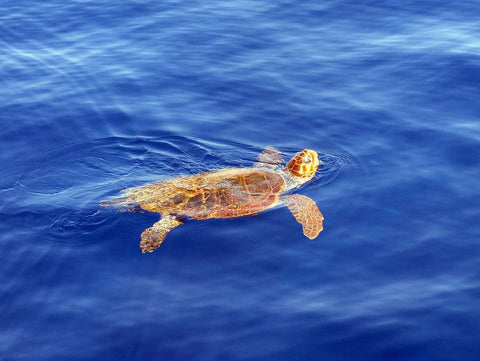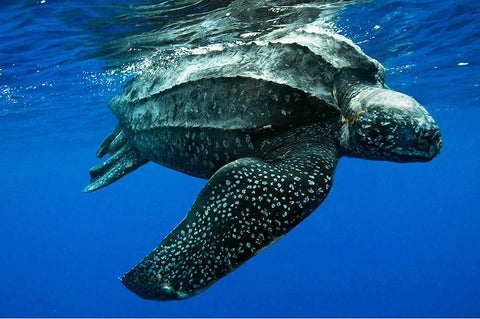Fishermen and bathers in pretty ethical swimsuits are not the only ones to appreciate the Mediterranean. The Mediterranean Sea is also frequented by three species of sea turtles, two of which nest there and once harbored abundant populations: the loggerhead (Caretta caretta) and the green sea turtle (Chelonia mydas) . The leatherback turtle (Dermochelys coriacea) is a rarer visitor.
Loggerhead sea turtle

The most common species in the Mediterranean is the loggerhead turtle (Caretta caretta). It was named after its large head equipped with strong jaws allowing the animal to break the hard shells of bivalves and crustaceans. Its nesting sites are located in tropical and subtropical regions, but it also inhabits temperate regions. Hatchlings are about 25mm long, while adults can be up to 100cm long and weigh up to 200kg. The nesting beaches in the Mediterranean are mainly located in the eastern part, especially in Greece, Turkey and Cyprus (where sustainable swimwear is highly valued). Most turtles inhabiting the Adriatic come from nesting beaches in Greece, especially the island of Zakynthos.
Loggerhead sea turtles live to be 60 years old and mature at 15 to 20 years old. The females return to the sandy beach where they were born to lay between 80 and 120 eggs in a nest. Loggerheads lay three or four nests each season, but only every three or four years. A female will return to the sea if disturbed during spawning. The incubation time of eggs until hatching is 55-60 days.
The green turtle

The green sea turtle (Chelonia mydas) was named after its green fatty tissue responsible for the general appearance of the animal. It can reach up to 120 cm in length. Developing juveniles feed on invertebrates such as jellyfish and become herbivorous when they reach sexual maturity, feeding on algae and seagrass. This happens between the ages of 20 and 40. This is a very widespread species. Nesting sites are located in the tropics, but turtles can also be found in temperate waters.
In the Mediterranean, the green turtle is reported in low numbers (since 1830) but, as it can be confused with the loggerhead turtle, its presence is likely to be underestimated. The green sea turtle is listed as an endangered species . The Mediterranean population is the smallest and most threatened of all. Nesting beaches are located mainly in Cyprus and Turkey, but there are also some in Lebanon, Egypt and Israel. You could meet some in these places when you walk on the beach in your eco-responsible swimsuit.
leatherback turtle

The leatherback turtle (Dermochelys coriacea) is the largest species of sea turtle with a shell up to two meters long. It can dive up to 1,000 m deep, more than any other turtle! It is easily distinguished by the absence of a bony shell, characteristic of other species of sea turtles. The skin-covered shell allows it to withstand high water pressure. The leatherback turtle is the most common species of sea turtle. It is found at sea, from Alaska in the north to the Cape of Good Hope in the south.
Despite its wide distribution, the leatherback sea turtle appears to be rather rare, with only 30 individuals recorded across the Adriatic since 1894. It is the only Mediterranean sea turtle species without any nesting sites in the basin. Adult animals can be over 180cm long and weigh 500kg or more. They feed on gelatinous zooplankton, such as jellyfish and salps, throughout their lives.


